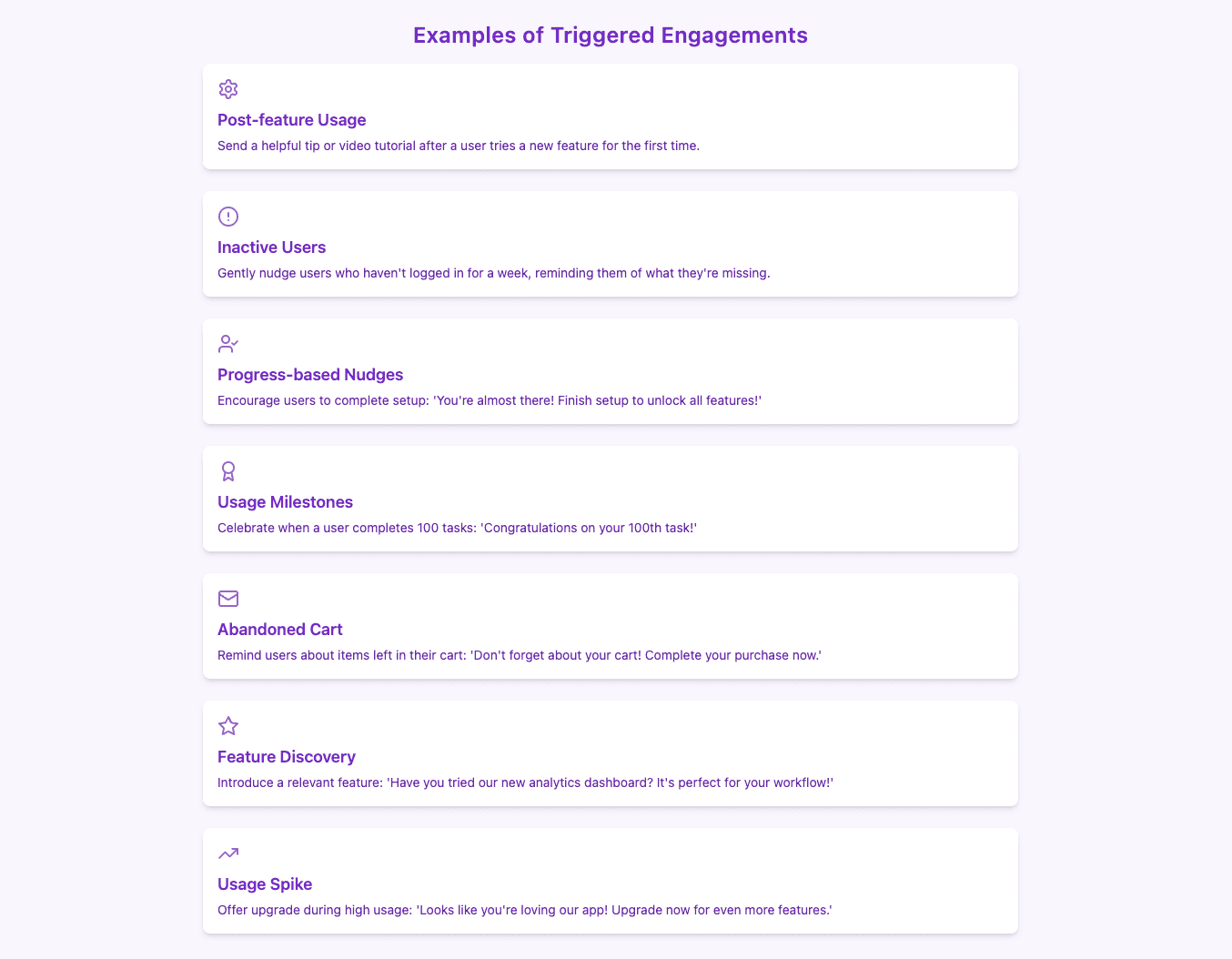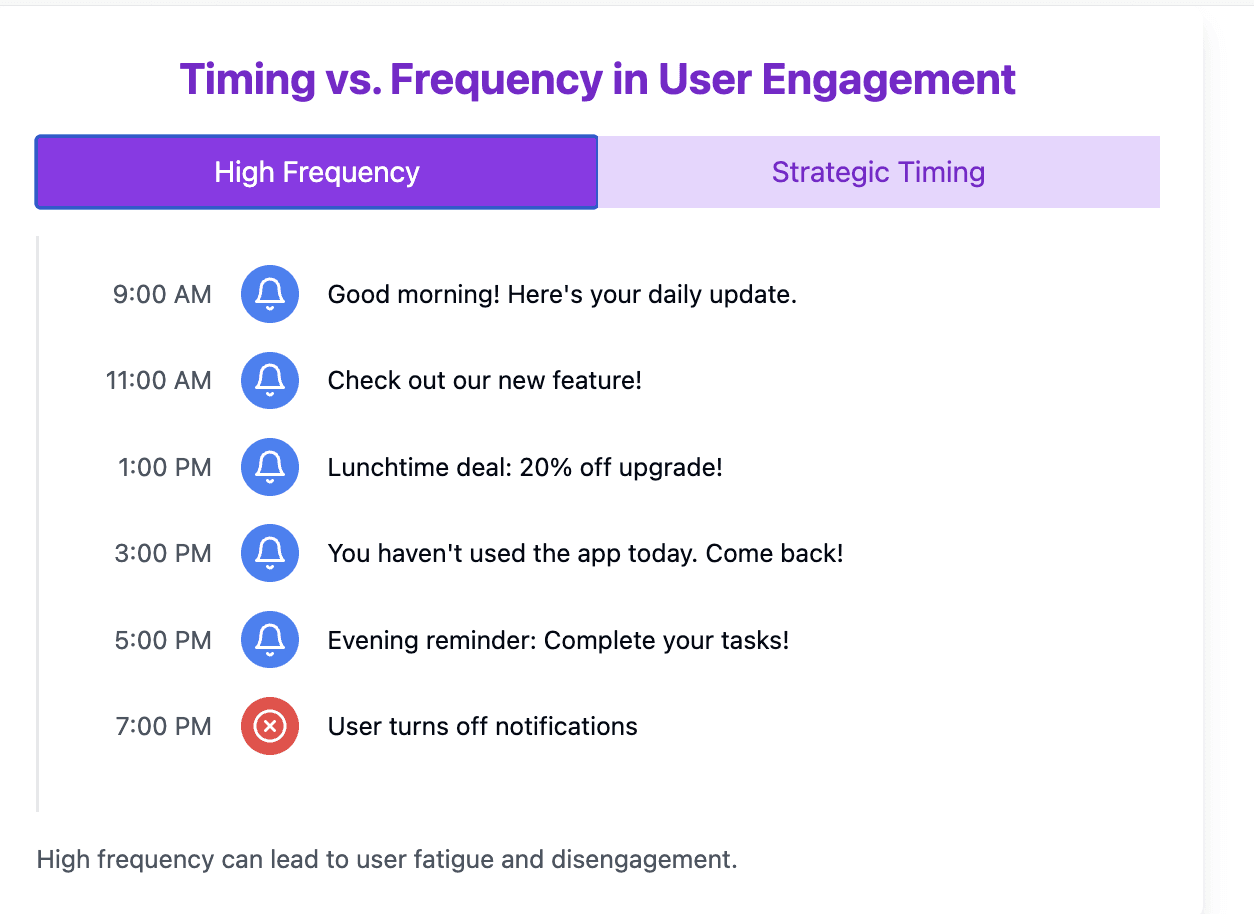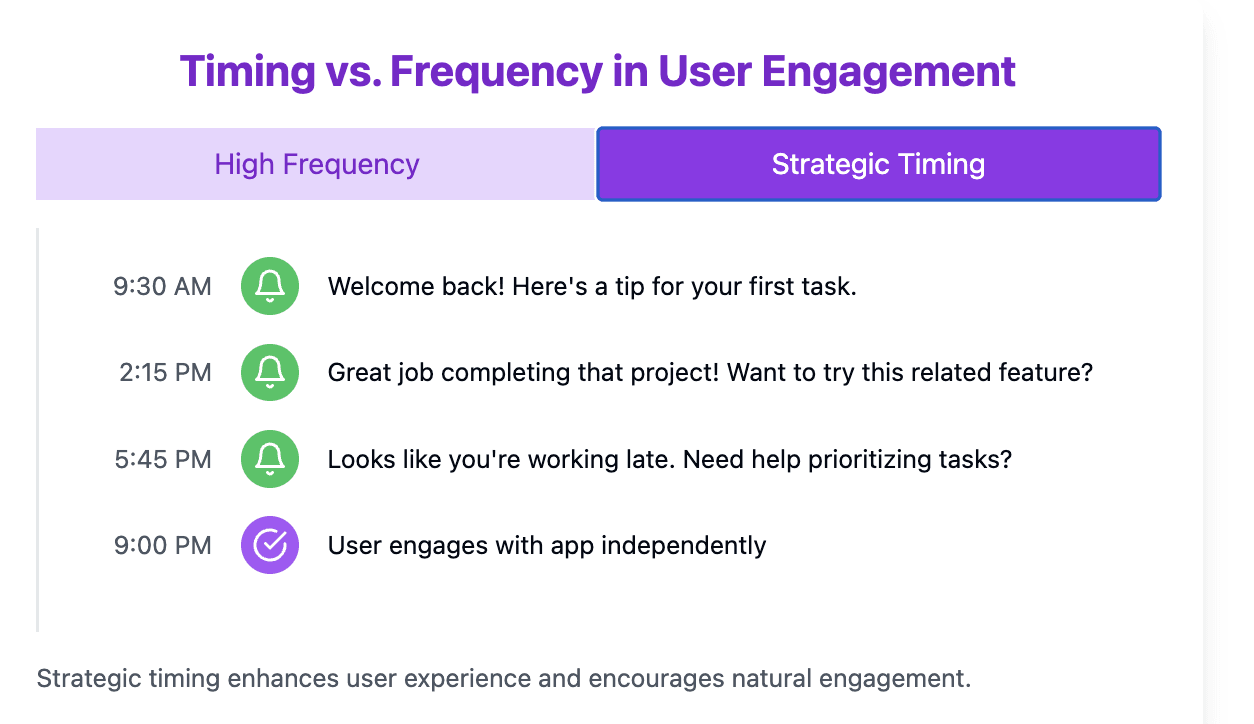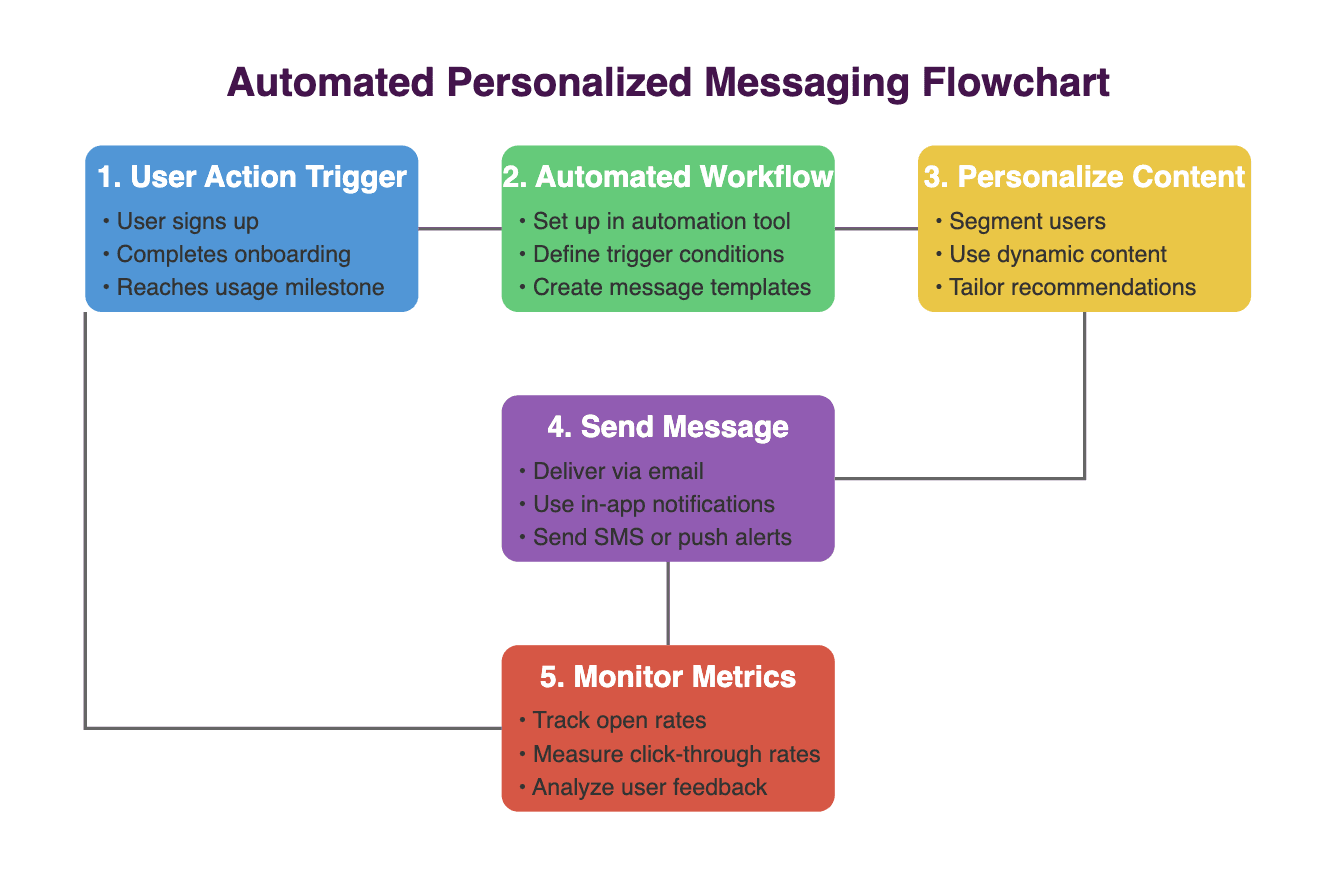
Mastering Customer Engagement Timing in SaaS

by
Wiktoria Slowikowska
Oct 15, 2024
Identify and convert your most valuable users
Sign Up
Customer engagement isn't just about reaching out—it's about reaching out at the right moment. Timing can make all the difference between a user feeling supported and engaged or overwhelmed and disinterested. For SaaS companies, mastering the science of timing can lead to significantly higher user engagement, reduced churn, and long-term success.
But what exactly does “perfect timing” mean when it comes to user engagement? It’s all about identifying the key moments when users are most receptive to communication and providing value when they need it most. This blog will explore how SaaS companies can leverage data, use behavioral triggers, and focus on timing over frequency to maximize customer engagement.
Why Timing Is Crucial for SaaS Engagement

Timing is everything in user engagement, and its importance in SaaS is even more pronounced because of the subscription-based nature of the business. With traditional product sales, the relationship between customer and company often ends at the point of purchase. In contrast, the SaaS model requires ongoing, long-term relationships where the customer's experience over time drives revenue growth through renewals, upsells, and expansions.
Effective engagement happens at the intersection of user needs and relevant product offerings. At any given moment, users have different levels of interest or need for a SaaS product. A perfectly timed engagement message shows that your platform is attuned to their specific situation, demonstrating an understanding of their goals, challenges, and behaviors. This connection builds trust and keeps users coming back.
Failure to consider timing can have the opposite effect. Poorly timed interactions—such as bombarding users with tips they don’t need or overloading them with notifications—can lead to disengagement, increased churn rates, and even frustration with your product.
Let's take a deeper look at how SaaS companies can use data, behavior-triggered actions, and strategic timing to engage users effectively.
Leveraging Data to Identify Key Engagement Moments
Effective SaaS customer engagement relies heavily on data-driven insights. To understand when to engage users, it’s essential to know their behaviors, patterns, and habits. Modern SaaS platforms have the advantage of collecting vast amounts of data on user interactions. The key is to use that data to find the most opportune moments for engagement.
For example:
After users complete a key action: When users successfully finish a critical task (e.g., setting up their profile, integrating with third-party apps), this is an ideal time to engage. A simple congratulatory message or offering a next step can drive further engagement.
When users haven’t interacted in a while: Inactivity is a strong indicator that users might be drifting away. Sending a personalized message reminding them of key features they haven’t explored or offering help at this moment can rekindle their interest.
To achieve this, SaaS companies must first establish user segments based on various factors such as behavior, usage frequency, and engagement levels. By doing so, companies can tailor their engagement strategies to align with each group’s specific needs. For example, new users may need more hand-holding and onboarding support, while power users may benefit from tips on advanced features or integrations that can enhance their experience.
Predictive analytics also come into play here. By using machine learning algorithms to analyze historical data, companies can predict when users are likely to become disengaged. These predictions allow for proactive engagement strategies that re-engage users before they lose interest.
Triggered Engagement Based on User Behavior
Engagement should feel natural and aligned with the user’s journey. One of the best ways to ensure this is by using triggered engagement—automated messages or notifications that are sent based on specific user behaviors. This strategy ensures that users receive timely nudges that correspond with their current needs or actions.
For instance:
Post-feature usage: After a user tries a new feature for the first time, following up with a helpful tip or a video tutorial on how to make the most of it can deepen their understanding and encourage continued use.
Inactive users: If a user hasn’t logged in for a week, a gentle nudge reminding them of what they’re missing out on—perhaps paired with an incentive like a free feature trial—can re-engage them.
Examples of triggered engagements could be:
Progress-based nudges: If a user is halfway through a setup process or workflow, offering encouragement to complete it can boost engagement. For instance, "You're almost there! Complete your setup to unlock full features!"
Usage milestones: Celebrate when a user hits an engagement milestone. It could be as simple as completing 100 tasks in a project management tool, which keeps the user invested in your platform.

One prime example of using behavioral triggers effectively is Spotify, where personalized recommendations like "Discover Weekly" playlists are triggered based on users’ listening habits. The platform’s ability to engage users with perfectly timed suggestions keeps them coming back, building a strong sense of habit and personalization.
By responding to users’ actions in real-time, SaaS companies ensure that their communications are not just timely, but also contextually relevant.
Timing Over Frequency: Quality vs. Quantity

When it comes to engagement, more isn't always better. While it might seem like constant communication would keep users interested, too much engagement—especially if it’s irrelevant or poorly timed—can quickly lead to fatigue. The focus should be on quality and timing over sheer volume.
Why does timing matter more than frequency?

Avoiding overload: Users are bombarded with messages from countless apps and services. If your engagement efforts aren’t carefully timed, they risk getting lost in the noise. Instead of bombarding users with daily messages, focus on delivering communication that is well-timed to their needs and current usage status.
Creating anticipation: Users should look forward to receiving messages from your SaaS platform because they consistently provide value. When engagement is timed well—like a tip when it’s needed, a reminder when something is left unfinished, or a personalized offer—it builds trust and anticipation. Users will know that your product is there to help, not to spam.
Driving long-term engagement: Well-timed messages aren’t just about immediate action—they are about building habits. A perfectly timed reminder to log in after a period of inactivity can gradually turn a casual user into an engaged power user. By delivering value at the right moment, you encourage users to come back and explore more on their own.
A well-timed engagement strategy can reduce churn rates and create a strong emotional bond between the user and the product. Take Duolingo, for example. Its use of daily reminders to maintain language-learning streaks is an example of timely engagement that motivates users to return to the app day after day. This strategy is particularly effective for SaaS companies where long-term retention is key to profitability.
The Importance of Personalization in Timing
While timing is critical, combining it with personalization amplifies its impact. Generic messages, even when timed well, don’t have the same effect as personalized communications that cater to a user’s specific needs, preferences, or behaviors. Users want to feel like the product understands their unique journey, and personalization is the key to unlocking that experience.
To achieve this, SaaS companies should:
Segment users based on activity levels, use cases, or engagement history.
Create personalized onboarding flows based on user goals (e.g., enterprise vs. individual users).
Offer tailored tips, reminders, or feature suggestions based on what a user has already done within the product.
Use tools like Hyperaktiv.ai, where you can hyper-personalize your messages. Hyperaktiv.ai adjusts the tone of voice based on the role of the recipient, tailoring language to ensure it resonates with their specific needs and preferences. Additionally, the platform automatically selects the optimal timing for engagement based on the recipient's location and context, enhancing the effectiveness of your communication and increasing the likelihood of meaningful interactions.
For example, a project management SaaS platform might send new users tips on organizing their first project, while experienced users could receive suggestions for advanced automations or integrations based on their current usage patterns.
Personalization makes timing even more effective by delivering relevant, helpful, and valuable content when the user needs it most.
Putting the Science of Timing into Practice
To apply these strategies effectively, SaaS companies can leverage tools like customer journey mapping, automation, and predictive analytics. These tools allow businesses to not only understand where each user is in their journey but also predict when they might need a nudge.
Here’s how SaaS companies can start:
1. Map Out Key Engagement Points Across the Customer Journey
Mapping out key engagement points in the customer journey is essential for understanding when and how to connect with users effectively. Identifying critical moments—such as onboarding, post-usage, and post-inactivity—allows you to tailor your communication and support strategies accordingly. By focusing on these touchpoints, you can create more meaningful interactions that drive user engagement and satisfaction.
How to Do It:
Identify Customer Stages:
Start by defining the different stages of your customer journey. Common stages include awareness, onboarding, active use, renewal, and churn.
Use customer personas to understand the unique experiences and needs of various user segments.
Analyze User Behavior:
Leverage analytics tools to track user interactions and behaviors at each stage. This may include time spent on features, frequency of use, or drop-off points.
Conduct surveys or interviews to gather qualitative insights into user experiences and pain points.
Map Engagement Touchpoints:
Create a visual map that highlights key engagement touchpoints within each stage. This should include interactions such as email communications, in-app notifications, support channels, and user feedback opportunities.
Identify specific moments when proactive engagement can add value, such as sending onboarding tips after a user signs up or offering assistance after a milestone is achieved.
2. Use Automation to Trigger Personalized Messages at Key Moments

Leveraging automation to trigger personalized messages ensures that users receive timely and relevant communications without overwhelming your team. By setting up automated workflows based on user behavior—such as completing onboarding or experiencing inactivity—you can deliver targeted content that meets users' immediate needs. This proactive approach not only enhances the user experience but also fosters a deeper connection between users and your product.
How to Do It:
Set Up Automated Workflows:
Utilize marketing automation software to create automated workflows for specific user actions, such as signing up, completing onboarding, or showing inactivity.
Define triggers that initiate these workflows. For instance, send a welcome email immediately after signup or a check-in message if a user hasn’t logged in for a week.
Personalize Content:
Segment your users based on criteria like behavior, demographics, or usage patterns to ensure messages are tailored to their needs.
Use dynamic content in emails or notifications that reflects individual user data, such as their first name, usage statistics, or personalized recommendations.
Monitor Engagement Metrics:
Regularly analyze the performance of your automated messages to assess their effectiveness. Key metrics include open rates, click-through rates, and user feedback.
Refine your messaging strategy based on data insights to improve engagement and response rates.
3. Test and Optimize Engagement Timing by Using A/B Testing
A/B testing is a powerful tool for fine-tuning your engagement strategies and determining the most effective timing for your messages. By experimenting with different timing and messaging approaches, you can identify what resonates best with users and optimize your communication efforts. Regularly analyzing the results of these tests allows you to adapt your strategy, ensuring you continually engage users when they are most receptive.
How to Do It:
Define Your Goals:
Clearly outline what you aim to achieve with your A/B tests, such as increased user engagement, improved retention, or higher conversion rates.
Identify the specific messages or touchpoints you want to test, such as onboarding emails, re-engagement campaigns, or feature announcements.
Conduct A/B Tests:
Split your audience into two or more groups, exposing each group to different variations of your messages (e.g., different sending times, content styles, or formats).
Run tests for a sufficient duration to gather meaningful data, ensuring that external factors (like seasonality) are accounted for.
Analyze Results:
After running your tests, analyze the data to determine which version performed better based on your predefined metrics. Use statistical analysis to ensure results are statistically significant.
Implement the winning variation while continuing to iterate and test other aspects of your messaging strategy for continuous improvement.
Conclusion
In SaaS, it’s not just what you say to engage users—it’s when you say it. By leveraging data, using triggered actions, and focusing on timing over frequency, SaaS companies can ensure that their user engagement strategies feel relevant, timely, and valuable. Perfectly timed engagement not only improves the customer experience but also increases long-term retention and satisfaction.
Mastering the science of timing is an ongoing process, but when done right, it creates a seamless, engaging, and personalized user experience that keeps customers coming back for more.




